Linné to name this genus chose a Greek name (diospyros) meaning “food of the gods“, that is to say that he knew the importance of this fruit for Asian cultures. Originally from China, the Kaki Fruit has been cultivated for a very long time in Japan, where its common name probably comes from, although some etymologists prefer a Hindi root (kaki meaning “color of dust” in this language). It is now grown in all warm regions of the globe, only a few species can grow outside the tropics, especially in the Mediterranean areas and the Caucasus.
In our region it has been cultivated for a long time in northern Vietnam where there are many varieties, different in shape or color. The flowers appear in May. The reproduction of Kaki is particular because of the flowers which are of three kinds: male, female or hermaphrodite; by playing with these elements and with pollination we obtain seedless fruits, this is the case of those currently sold in Laos.
The fruit is a large globose berry with thin membranous skin, orange-yellow or tomato red, with more or less soft flesh, sometimes almost liquid, with a mild, sweet, pleasant flavor. Some varieties give astringent fruits (rich in tannin) which must be soft to become edible, others like fuyu, suruga or sharon (cultivated in Israel, the world’s leading producer with 30,000 tonnes in 2005) give non-astringent fruits which can be eaten crisp like an apple. In addition, the degree of sourness of the fruits depends very much on the place of production.
In China, Korea and Japan Persimmons are eaten fresh but also dried or infused in alcohol. In these countries they also have a strong symbolic and artistic value. We love the persimmon for its incomparable beauty when its leaves, initially red with copper highlights, fall to give way to the only fruiting bodies which then seem suspended like lanterns. The shape of the fruit characterized by its persistent calyx has always inspired many Chinese and Japanese painters.
In traditional Asian medicines, Persimmon is considered astringent, pectoral and stomachic. Our doctor-botanist Petelot (1941) adds that: “According to the notes of a missionary “it produces contentment and peace of heart, it clears the nose and is the enemy of alcohol, so one must abstain from giving this fruit to a drunken man who would die of it”.
What is certain is that the high sugar content and the presence of vitamin C and iron make this fruit a valuable nutrient.
Linné pour nommer ce genre a choisi un nom grec (diospyros) signifiant « aliment des dieux », c’est dire qu’il savait l’importance de ce fruit pour les cultures asiatiques. Originaire de Chine, le kaki est très anciennement cultivé au Japon d’où nous vient sans doute son nom commun, bien que certains étymologistes préfèrent une racine hindi (kaki signifiant « couleur de poussière » dans cette langue). Il est désormais cultivé dans toutes les régions chaudes du globe, quelques espèces seulement peuvent se développer en dehors des tropiques, notamment dans les zones méditerranéennes et au Caucase.
Dans notre région, il est cultivé depuis longtemps au Nord du Vietnam où il en existe de nombreuses variétés, différentes par la forme ou la couleur. Les fleurs apparaissent au mois de mai. La reproduction des Kaki est particulière du fait des fleurs qui sont de trois genres: mâles, femelles ou hermaphrodites; en jouant avec ces éléments et avec la pollinisation on obtient des fruits sans pépins, c’est le cas de ceux vendus actuellement au Laos.
Le fruit est une grosse baie globuleuse à peau fine membraneuse, jaune orangé ou rouge tomate, à chair plus ou moins molle, parfois presque liquide ayant une saveur douce, sucrée, agréable. Certaines variétés donnent des fruits astringents (riches en tanin) qui doivent être mous pour devenir consommables, d’autres comme fuyu, suruga ou sharon (cultivé en Israël, premier producteur mondial avec 30.000 tonnes en 2005) donnent des fruits non astringents qui peuvent être consommés croquants comme une pomme. En outre, le degré d’âpreté des fruits dépend beaucoup du lieu de production.
En Chine, en Corée et au Japon les kakis sont consommés frais mais aussi séchés ou infusés dans de l’alcool. Dans ces pays ils sont aussi une valeur symbolique et artistique forte. On aime le kaki pour sa beauté incomparable lorsque ses feuilles, d’abord rouges à reflets cuivrés, tombent pour laisser place aux seules fructifications qui semblent alors suspendues comme des lanternes. La forme du fruit caractérisé par son calice persistant a toujours inspiré de nombreux peintres chinois et japonais.
Dans les médecines traditionnelles asiatiques le kaki est considéré comme astringent, pectoral et stomachique. Notre médecin-botaniste Petelot (1941) ajoute que : « D’après les notes d’un missionnaire « il produit le contentement et la paix du cœur, il débouche le nez et est l’ennemi de l’alcool, aussi faut-il s’abstenir de donner ce fruit à un homme ivre qui en mourrait » ».
Ce qui est certain, c’est que la grande teneur en sucre et la présence de vitamine C et de fer font de ce fruit un précieux élément nutritif.
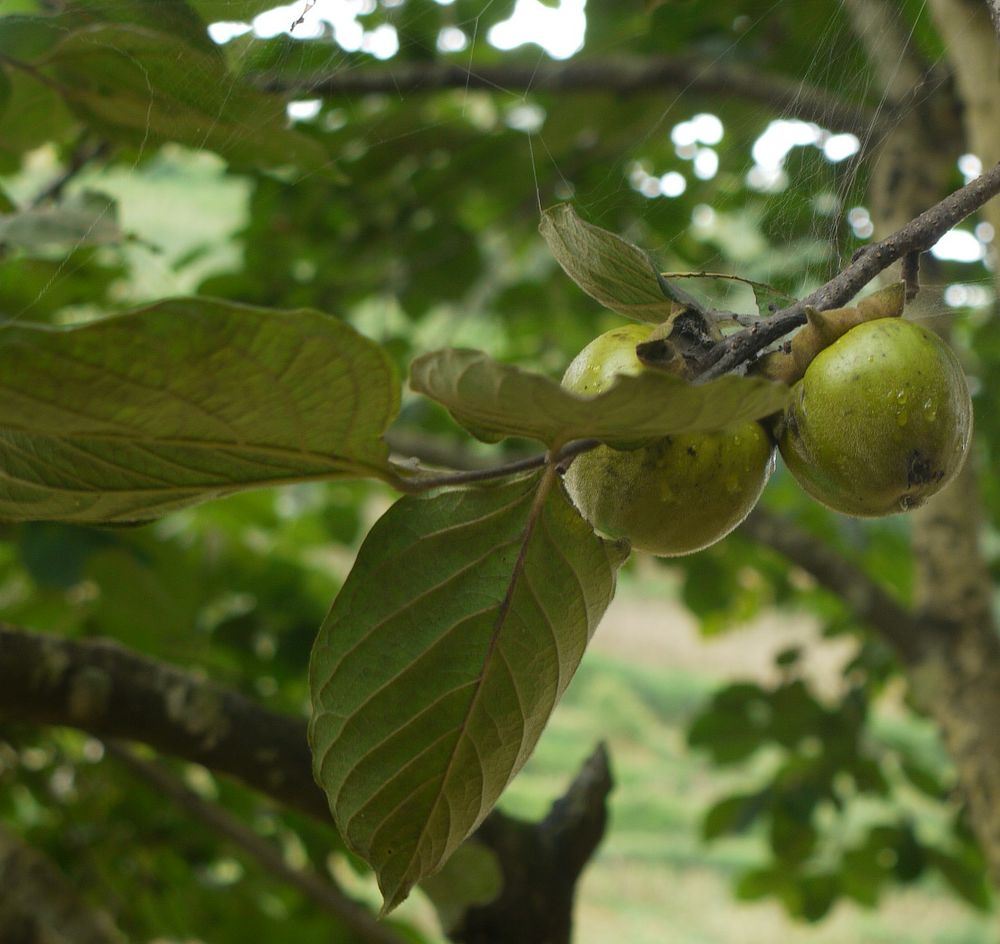
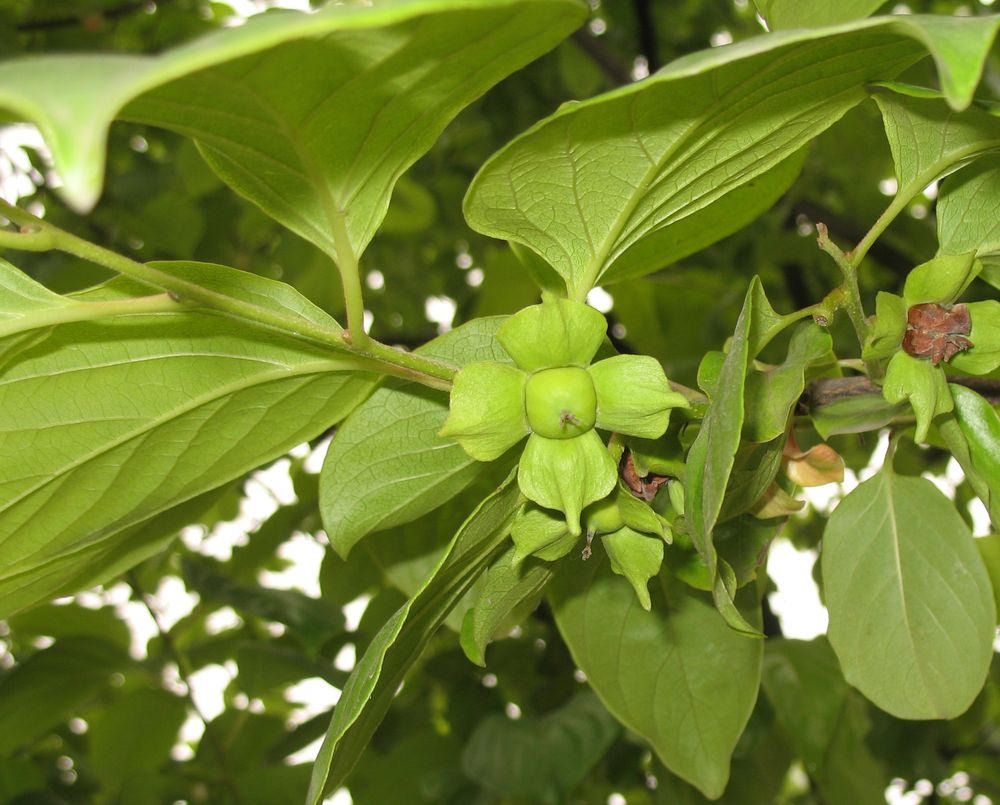
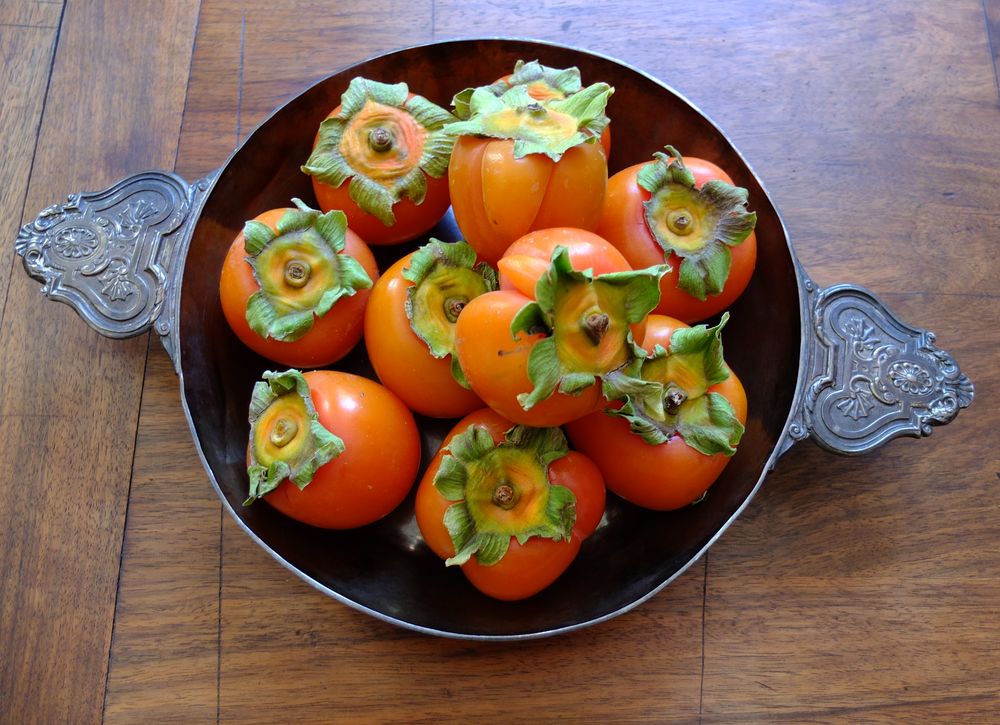
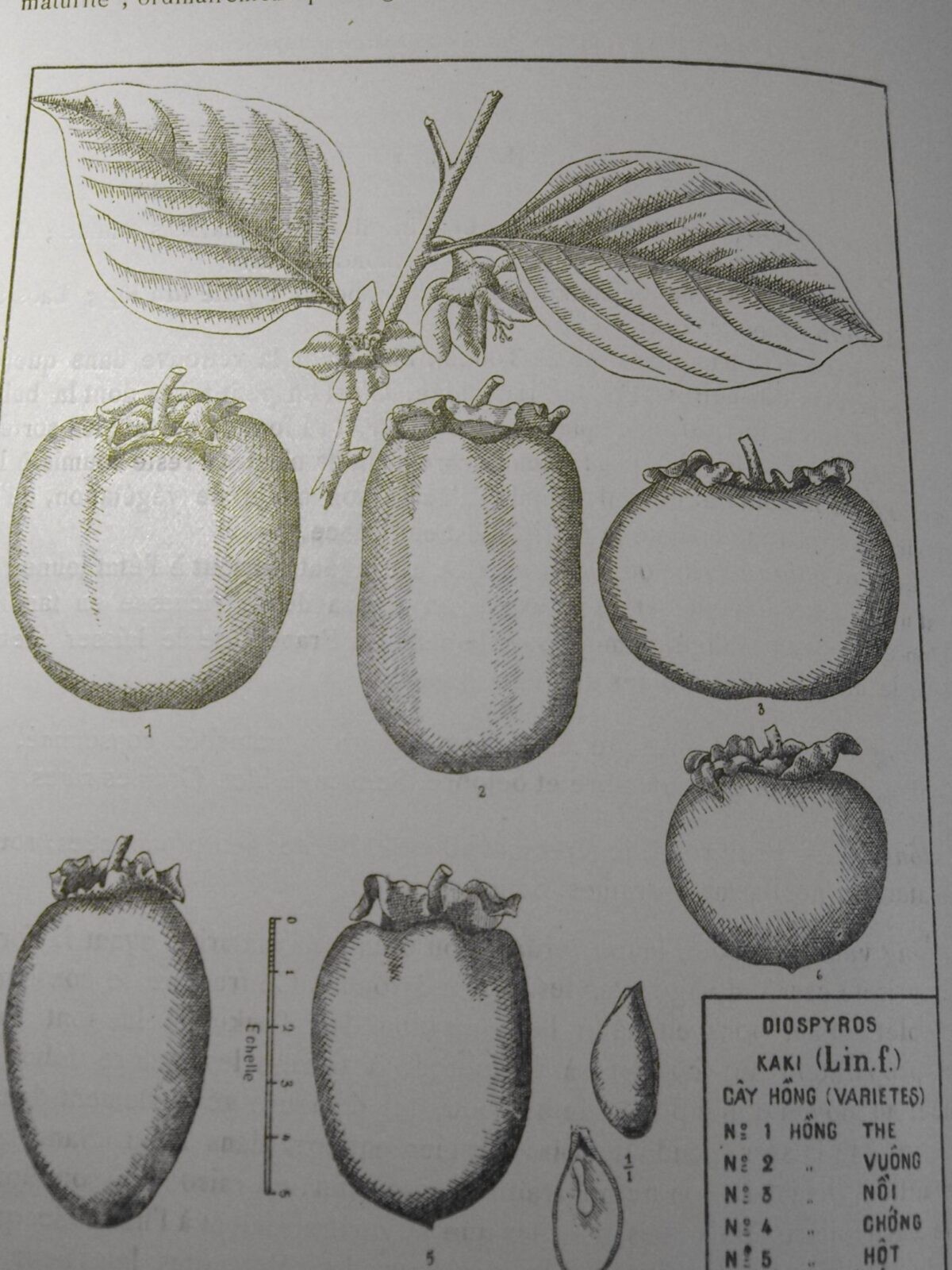
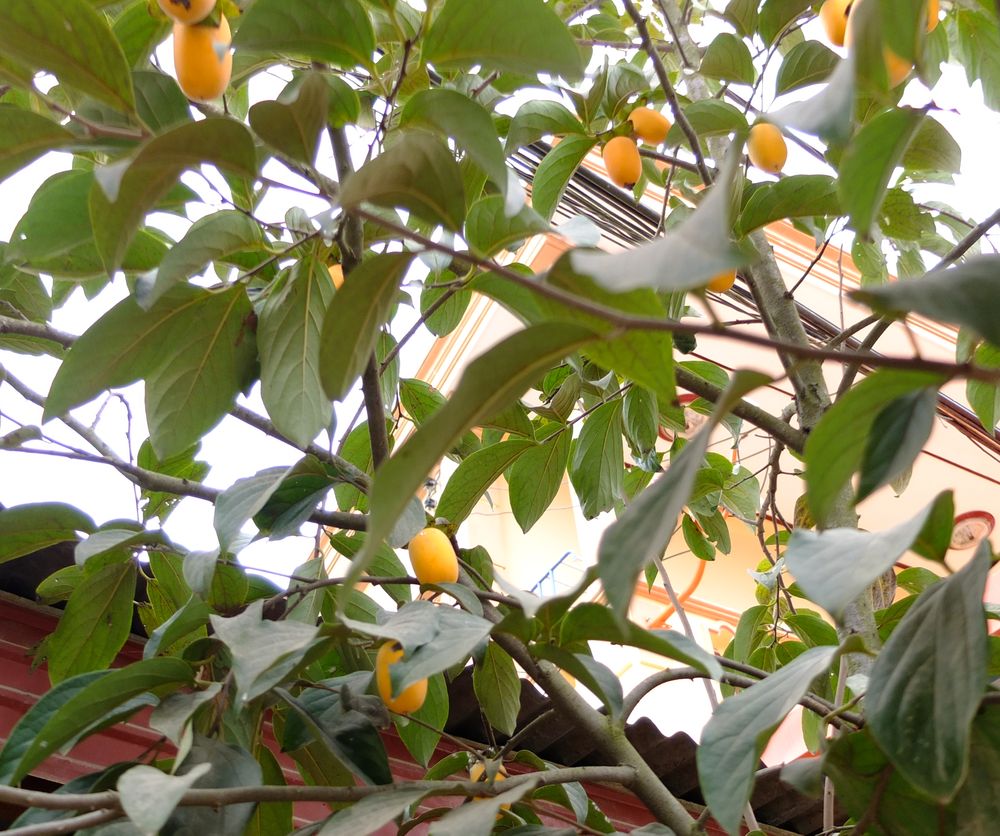
Linné to name this genus chose a Greek name (diospyros) meaning “food of the gods“, that is to say that he knew the importance of this fruit for Asian cultures. Originally from China, the Kaki Fruit has been cultivated for a very long time in Japan, where its common name probably comes from, although some etymologists prefer a Hindi root (kaki meaning “color of dust” in this language). It is now grown in all warm regions of the globe, only a few species can grow outside the tropics, especially in the Mediterranean areas and the Caucasus.
In our region it has been cultivated for a long time in northern Vietnam where there are many varieties, different in shape or color. The flowers appear in May. The reproduction of Kaki is particular because of the flowers which are of three kinds: male, female or hermaphrodite; by playing with these elements and with pollination we obtain seedless fruits, this is the case of those currently sold in Laos.
The fruit is a large globose berry with thin membranous skin, orange-yellow or tomato red, with more or less soft flesh, sometimes almost liquid, with a mild, sweet, pleasant flavor. Some varieties give astringent fruits (rich in tannin) which must be soft to become edible, others like fuyu, suruga or sharon (cultivated in Israel, the world’s leading producer with 30,000 tonnes in 2005) give non-astringent fruits which can be eaten crisp like an apple. In addition, the degree of sourness of the fruits depends very much on the place of production.
In China, Korea and Japan Persimmons are eaten fresh but also dried or infused in alcohol. In these countries they also have a strong symbolic and artistic value. We love the persimmon for its incomparable beauty when its leaves, initially red with copper highlights, fall to give way to the only fruiting bodies which then seem suspended like lanterns. The shape of the fruit characterized by its persistent calyx has always inspired many Chinese and Japanese painters.
In traditional Asian medicines, Persimmon is considered astringent, pectoral and stomachic. Our doctor-botanist Petelot (1941) adds that: “According to the notes of a missionary “it produces contentment and peace of heart, it clears the nose and is the enemy of alcohol, so one must abstain from giving this fruit to a drunken man who would die of it”.
What is certain is that the high sugar content and the presence of vitamin C and iron make this fruit a valuable nutrient.
Linné pour nommer ce genre a choisi un nom grec (diospyros) signifiant « aliment des dieux », c’est dire qu’il savait l’importance de ce fruit pour les cultures asiatiques. Originaire de Chine, le kaki est très anciennement cultivé au Japon d’où nous vient sans doute son nom commun, bien que certains étymologistes préfèrent une racine hindi (kaki signifiant « couleur de poussière » dans cette langue). Il est désormais cultivé dans toutes les régions chaudes du globe, quelques espèces seulement peuvent se développer en dehors des tropiques, notamment dans les zones méditerranéennes et au Caucase.
Dans notre région, il est cultivé depuis longtemps au Nord du Vietnam où il en existe de nombreuses variétés, différentes par la forme ou la couleur. Les fleurs apparaissent au mois de mai. La reproduction des Kaki est particulière du fait des fleurs qui sont de trois genres: mâles, femelles ou hermaphrodites; en jouant avec ces éléments et avec la pollinisation on obtient des fruits sans pépins, c’est le cas de ceux vendus actuellement au Laos.
Le fruit est une grosse baie globuleuse à peau fine membraneuse, jaune orangé ou rouge tomate, à chair plus ou moins molle, parfois presque liquide ayant une saveur douce, sucrée, agréable. Certaines variétés donnent des fruits astringents (riches en tanin) qui doivent être mous pour devenir consommables, d’autres comme fuyu, suruga ou sharon (cultivé en Israël, premier producteur mondial avec 30.000 tonnes en 2005) donnent des fruits non astringents qui peuvent être consommés croquants comme une pomme. En outre, le degré d’âpreté des fruits dépend beaucoup du lieu de production.
En Chine, en Corée et au Japon les kakis sont consommés frais mais aussi séchés ou infusés dans de l’alcool. Dans ces pays ils sont aussi une valeur symbolique et artistique forte. On aime le kaki pour sa beauté incomparable lorsque ses feuilles, d’abord rouges à reflets cuivrés, tombent pour laisser place aux seules fructifications qui semblent alors suspendues comme des lanternes. La forme du fruit caractérisé par son calice persistant a toujours inspiré de nombreux peintres chinois et japonais.
Dans les médecines traditionnelles asiatiques le kaki est considéré comme astringent, pectoral et stomachique. Notre médecin-botaniste Petelot (1941) ajoute que : « D’après les notes d’un missionnaire « il produit le contentement et la paix du cœur, il débouche le nez et est l’ennemi de l’alcool, aussi faut-il s’abstenir de donner ce fruit à un homme ivre qui en mourrait » ».
Ce qui est certain, c’est que la grande teneur en sucre et la présence de vitamine C et de fer font de ce fruit un précieux élément nutritif.










Linné to name this genus chose a Greek name (diospyros) meaning “food of the gods“, that is to say that he knew the importance of this fruit for Asian cultures. Originally from China, the Kaki Fruit has been cultivated for a very long time in Japan, where its common name probably comes from, although some etymologists prefer a Hindi root (kaki meaning “color of dust” in this language). It is now grown in all warm regions of the globe, only a few species can grow outside the tropics, especially in the Mediterranean areas and the Caucasus.
In our region it has been cultivated for a long time in northern Vietnam where there are many varieties, different in shape or color. The flowers appear in May. The reproduction of Kaki is particular because of the flowers which are of three kinds: male, female or hermaphrodite; by playing with these elements and with pollination we obtain seedless fruits, this is the case of those currently sold in Laos.
The fruit is a large globose berry with thin membranous skin, orange-yellow or tomato red, with more or less soft flesh, sometimes almost liquid, with a mild, sweet, pleasant flavor. Some varieties give astringent fruits (rich in tannin) which must be soft to become edible, others like fuyu, suruga or sharon (cultivated in Israel, the world’s leading producer with 30,000 tonnes in 2005) give non-astringent fruits which can be eaten crisp like an apple. In addition, the degree of sourness of the fruits depends very much on the place of production.
In China, Korea and Japan Persimmons are eaten fresh but also dried or infused in alcohol. In these countries they also have a strong symbolic and artistic value. We love the persimmon for its incomparable beauty when its leaves, initially red with copper highlights, fall to give way to the only fruiting bodies which then seem suspended like lanterns. The shape of the fruit characterized by its persistent calyx has always inspired many Chinese and Japanese painters.
In traditional Asian medicines, Persimmon is considered astringent, pectoral and stomachic. Our doctor-botanist Petelot (1941) adds that: “According to the notes of a missionary “it produces contentment and peace of heart, it clears the nose and is the enemy of alcohol, so one must abstain from giving this fruit to a drunken man who would die of it”.
What is certain is that the high sugar content and the presence of vitamin C and iron make this fruit a valuable nutrient.
Linné pour nommer ce genre a choisi un nom grec (diospyros) signifiant « aliment des dieux », c’est dire qu’il savait l’importance de ce fruit pour les cultures asiatiques. Originaire de Chine, le kaki est très anciennement cultivé au Japon d’où nous vient sans doute son nom commun, bien que certains étymologistes préfèrent une racine hindi (kaki signifiant « couleur de poussière » dans cette langue). Il est désormais cultivé dans toutes les régions chaudes du globe, quelques espèces seulement peuvent se développer en dehors des tropiques, notamment dans les zones méditerranéennes et au Caucase.
Dans notre région, il est cultivé depuis longtemps au Nord du Vietnam où il en existe de nombreuses variétés, différentes par la forme ou la couleur. Les fleurs apparaissent au mois de mai. La reproduction des Kaki est particulière du fait des fleurs qui sont de trois genres: mâles, femelles ou hermaphrodites; en jouant avec ces éléments et avec la pollinisation on obtient des fruits sans pépins, c’est le cas de ceux vendus actuellement au Laos.
Le fruit est une grosse baie globuleuse à peau fine membraneuse, jaune orangé ou rouge tomate, à chair plus ou moins molle, parfois presque liquide ayant une saveur douce, sucrée, agréable. Certaines variétés donnent des fruits astringents (riches en tanin) qui doivent être mous pour devenir consommables, d’autres comme fuyu, suruga ou sharon (cultivé en Israël, premier producteur mondial avec 30.000 tonnes en 2005) donnent des fruits non astringents qui peuvent être consommés croquants comme une pomme. En outre, le degré d’âpreté des fruits dépend beaucoup du lieu de production.
En Chine, en Corée et au Japon les kakis sont consommés frais mais aussi séchés ou infusés dans de l’alcool. Dans ces pays ils sont aussi une valeur symbolique et artistique forte. On aime le kaki pour sa beauté incomparable lorsque ses feuilles, d’abord rouges à reflets cuivrés, tombent pour laisser place aux seules fructifications qui semblent alors suspendues comme des lanternes. La forme du fruit caractérisé par son calice persistant a toujours inspiré de nombreux peintres chinois et japonais.
Dans les médecines traditionnelles asiatiques le kaki est considéré comme astringent, pectoral et stomachique. Notre médecin-botaniste Petelot (1941) ajoute que : « D’après les notes d’un missionnaire « il produit le contentement et la paix du cœur, il débouche le nez et est l’ennemi de l’alcool, aussi faut-il s’abstenir de donner ce fruit à un homme ivre qui en mourrait » ».
Ce qui est certain, c’est que la grande teneur en sucre et la présence de vitamine C et de fer font de ce fruit un précieux élément nutritif.


